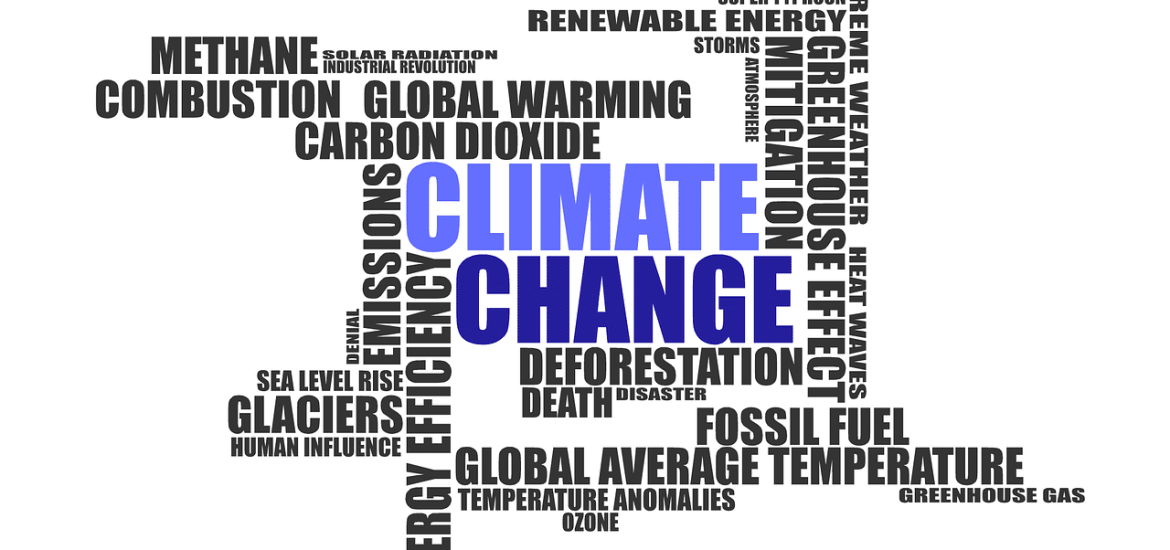
At the end of 2019, I had the chance to participate in a peer-review of the Sixth Assessment Report of the Intergovernmental Panel for Climate Change (IPCC). Although the texts that I assessed were still in their intermediary draft versions, I could readily observe a tendency towards generalisation of policy solutions in certain segments. It seems that many in the expert communities who work with the IPCC still perceive economic laws as being independent from their social contexts, as previous IPCC works also bear this similar pattern. For example, the most vocal special report produced by the IPCC in 2018 still induces a sense of climate urgency based on the Baseline scenario – a model based on a presumption of no-effort in reducing greenhouse gas (GHG) emissions. The Baseline scenario schematises a link between manmade climate change and its effects without taking in to account all the existing climate policies within the model.
However, this same IPCC special report also explicitly recognises the need for policy to be shaped more by socioeconomic realities, as it directly appeals for multiple pathways to abate manmade GHG and recommends an optimization of choices that maximize benefits for multiple sustainable development dimensions.[1] In this way, the IPCC points to the need for more relevant policy solutions aimed at tackling manmade climate change. Despite these arguments for multiple sustainable development dimensions, many in expert communities – including those who work with the IPCC – continue to push for a “one size fits all” approach.
Meanwhile, great strides in public awareness about climate change have undoubtedly been achieved. IPCC works have further been pivotal in the evolution of climate science itself[2], having foregrounded a clear definition of a global climate neutrality characterised by minimal amounts of GHG that are absorbable by the biosphere. The term ‘climate neutrality’ has now been integrated in to EU Climate Law [3], which declares ambitious targets of lowering greenhouse gas (GHG) to a net zero. This European initiative has simultaneously put pressure on other nations to take similar steps, as the climate emergency is now at the top of the global agenda.[4]
It is widely held that one of the main driving forces for mitigating human impact on GHG emissions is the decarbonisation of power generation, which constituted the fastest-growing source of carbon dioxide emissions over the last five decades.[5] The introduction of carbon-neutral renewable energies, a transition to e-mobility, and an increase of direct electricity consumption in residential sectors and industries have been extensively pointed out[6]. At the same time, one may easily observe that these economic solutions are already taking place across the most advanced economies, with empirical data further demonstrating a decoupling of their industrial development and carbon footprint. On this basis, the present article attempts to demonstrate that socioeconomic structures in the industrialized west have already shifted away from the IPCC Baseline scenario. Instead, GHG emissions have moved to emerging Asian economies with very different socioeconomic structures and policy practices. The decarbonisation of the power sector in emerging economies is often times not a sufficient solution in achieving global climate neutrality in IPCC terms. Continuous destruction of biosphere, rising emissions outside power sectors, difficulties jumpstarting ailing sectors of the economy – these are just a few of the complex set of problems facing developing nations. It also highlights why decarbonisation of the power sector is low priority for countries new to the world economy.
-
Looking at socioeconomic realities or revisiting the Baseline scenario
The first step in integrating socioeconomic complexities into the climate change mitigation solutions involves revisiting the IPCC Baseline scenario itself. By introducing the concept of ‘Baseline’, the IPCC aims to reveal pernicious effects stemming from GHG emissions on the environment and global economy. To prove this point, the IPCC utilises various computerised models based on a correlation between GHG and temperature increase over various periods of time. However, throughout the last decade, expert communities have pointed to the flaws inherent in the very concept of the ‘Baseline’ scenario – specifically, the absence of climate policies. In 2011, a scholarly article indicated a need to renew the Baseline by exploring ‘the impact of different climate policies in addition to the no-climate-policy scenarios’.[7] The authors highlighted that a total absence of climate change mitigation efforts would exist only in a theoretical model. Other observers revealed that modelers tend to follow high emissions scenarios in order to maintain continuity with past studies that use high emissions scenarios[8]. Despite efforts to increase public consciousness about the climate change issue, this approach risks generating a mischaracterisation of the Baseline scenarios, defined by a complete lack of climate mitigation policies.
To illustrate the case, consider the IPCC special report’s assessment framework and methodologies[9], which contain an explicit reference to Coupled Models Intercomparison Project (CMIPs) developed within the World Climate Research Programme. These comprehensive climate assessment models have been used since 1995. Their initial experiments compare projections in response to ‘an idealized forcing’ defined by ‘a constant rate of increase which was accomplished using a CO2 increase of 1% per year compounded’.[10] This reference to constant value foregrounded business-as-usual scenarios based on an assumption of a continuous increase of greenhouse gas emissions. Furthermore, the IPCC special report indicates another multimodel experiment called ‘Half a degree Additional warming, Prognosis and Projected Impacts’ (HAPPI).
Further, the special report also refers to an academic article entitled ‘Uncertainties in the attribution of greenhouse gas warming and implications for climate prediction’ in order to demonstrate a performance in assessing climate changes at ‘1.5°C vs 2°C global warming’.[11] Contrary to the IPCC’s approach, the article to which the report refers actually calls for as many models to be included in CMIPs, ‘more practical recommendations of numbers of experiments and of ensemble members should be considered’, which would include historical GHG projections. Despite these important scientific observations and even an explicit reference to the article in question, the IPCC special report does not mention the findings. Unfortunately, the report risks to engender a skewed perception of the very projection needed by policymakers.
The possible distortion between models and reality have been widely debated in the aftermath of IPCC’s alarming conclusions[12]. Beyond models and theories, it is imperative that policymakers and even societies-at-large begin to understand whether the IPCC perspective on the Baseline scenario corresponds to a constant increase of greenhouse gases leading indeed to some worse-case scenarios. The answer to the question may require an overview of trends of carbon dioxide emissions generated by fossil fuels.
-
OECD Economies shift away from Baseline: gradual economy-emissions divorce
To assess the scale of manmade effect on climate, we must mainly consider GHG emissions from fossil fuels – defined as fossil carbon dioxide emissions – that constitute up to 75% of total GHG emissions. Evidence shows that global GHG emissions have been increasing over the last century. Four major sources of the fossil GHG emissions are the power sector, industry, transport, as well as residential sector, primarily buildings.
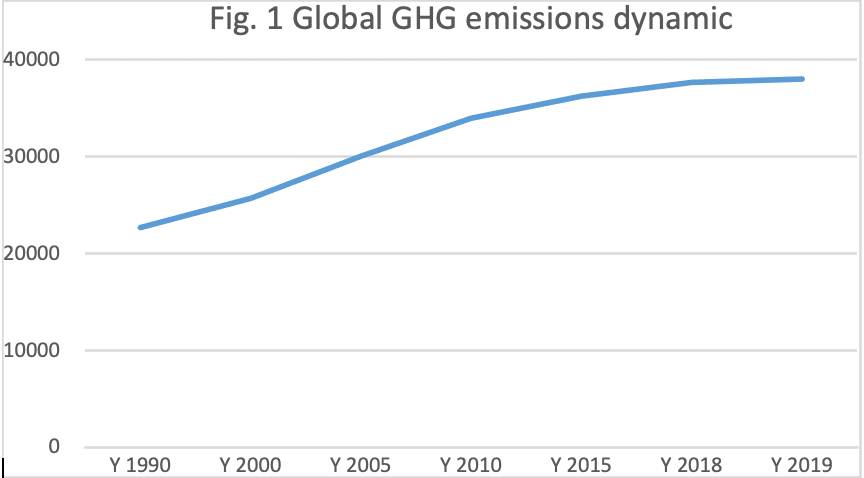
Source: European Commission, Emissions Database for Global Atmospheric Research, 2020
Fig 1 illustrates a sharp GHG increase during the 1990s, with continuous growth until 2008 – the year of the global financial crisis. However, in the aftermath, GHG emissions dynamics show slower growth.
To better understand if emissions rates have indeed declined, one may need to consider emissions intensity calculated as a relation between GHG growth and GDP growth. If we place GHG emissions in the context of WB data on global GDP provided by the World Bank, then we may even observe a decline in the ratio. In fact, economic growth per 5 years has exceeded the quinquennal increase in emissions.
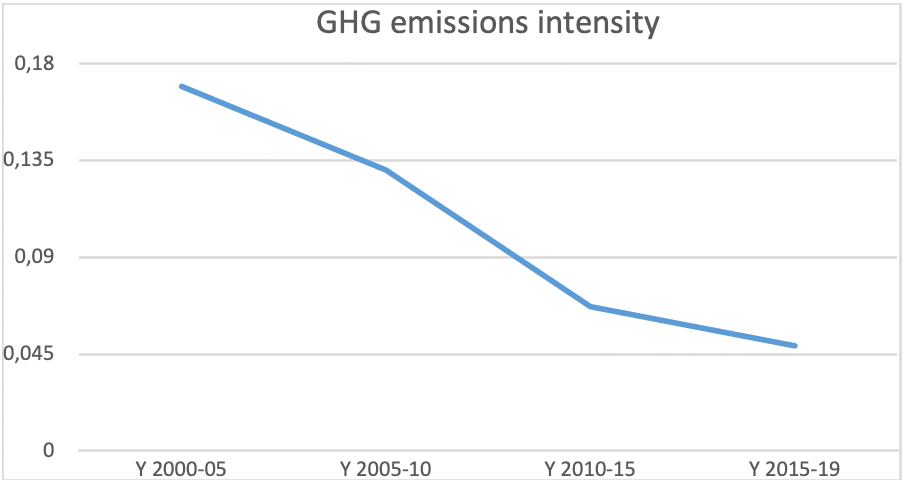
Source: author’s calculation, World Bank Data on World GDP, and European Commission, Emissions Database for Global Atmospheric Research, 2020
Even more, since 2010 emissions dynamics per GDP fell below 0.5, which actually means that economic development can be stimulated without direct correlation with emissions’ increase.
These empirical observations, which coincide with the conclusions drafted in the recent European Commission’s report on fossil GHG emissions, reveal that the EU is on track to bypass earlier targets in emission reduction by 20% from the level of 1990 by 2020.[13] EU-28 emissions have been declining with a rate of 0.3% per year since 2015, on average. Meanwhile, the European Commission notes that with a shift from coal to gas, noticeable emissions reduction occurred in Portugal (7.9%), Bulgaria (6.8%), Germany (5.0%), and Italy (3.3%).[14] In parallel, the US experienced a steady decline in GHG emissions due to the shale gas revolution and availability of cheap natural gas for power generation. BP data also confirms that US carbon dioxide emissions fell by about 2.5-3% per annum since 2015, with a sole exception of 2018.[15]
Both the EU and the US have seen an emergence of cleaner transport solutions, including higher standards for oil products, compressed natural gas vehicles, liquefied natural gas in maritime transport, and, ultimately, the emergence of electric vehicles. Thus, the transport sector – which has been one of the strongest drivers for emissions’ growth – became less GHG-intensive. Structural changes in their economies over the last two decades reveal that “going green” is now seen as an opportunity for economic development and prosperity.
-
Shifting emissions to new socio-economic realities
While the OECD economies have already been on the path to being low-carbon, issues with global climate neutrality are now in focus across the world’s emerging economies. East, South and Southeast Asia have observed a dramatic increase in fossil emissions (Fig. 3). From 2009 onwards, OECD energy demand was outstripped by non-OECD energy demand, resulting in significant changes for fossil emissions. According to the International Energy Agency, India’s economy is three times more dependent on oil than the EU. As a result, India has caught up to the EU in fossil GHG emissions and is projected to pass them by in the coming years. India‘s rapid industrialisation also affects land deterioration. To illustrate the scale of environmental damage in figures, around 60% of cultivated land has suffered from erosion. As a result, between 4.7 and 12 billion tons of topsoil have been lost annually since the end of the 20th century. [16] Consequences are dire for climate neutrality as land deterioration also contributes to deforestation, as acres of trees are harvested for fuel.
Land management and the prevention of deforestation are also important issues when promoting new energy sources. For instance, internationally renowned India’s Energy and Resource Institute has conducted research on the renewed demand for land arising from new energies like biofuels, solar and wind.[17]
Farther east, coal-dominated China’s power sector contributes to 40% of its national emissions, which is equivalent to 15% of the total global fossil emissions.[18] Impressive progress with renewable energy does little to lessen the carbon intensity of the world’s leader in emissions. Observation of the Chinese emissions’ structure further reveal that most emissions are still beyond the power sector, including hard-to-abate industries and transport. A recent report from a Beijing-based think tank reveals that the number of cars in China grew from 5,514 million to 185,755 million vehicles in the period between 1990 and 2016, which means an increase by 34 times since the last decade of the previous century.[19] This figure would still contain a margin for an incremental potential considering China’s population bypassed 1 billion inhabitants. One may further estimate serious challenges in a simultaneous decarbonisation of electricity and transport during the significant consumption growth in both sectors. Similar to India, a deterioration in underground waters lead to land deterioration, which certainly weakened the biosphere’s capacity to absorb emissions.[20]
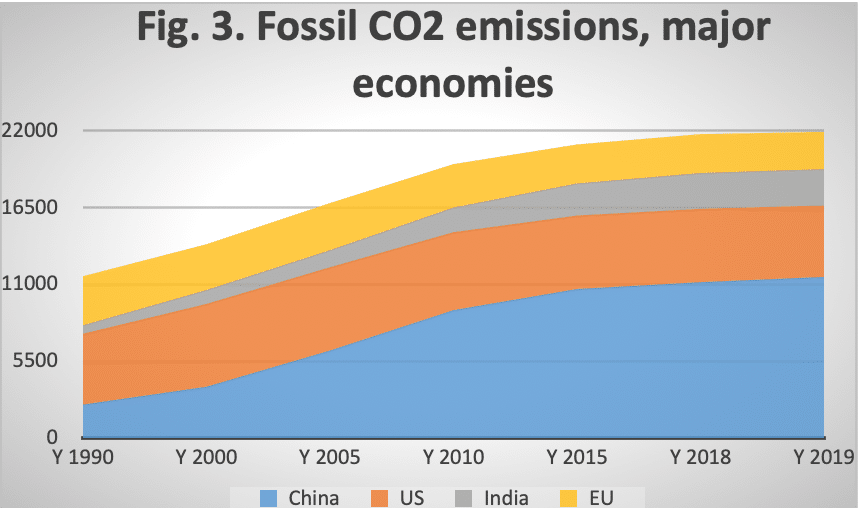
Source: European Commission, Emissions Database for Global Atmospheric Research, 2020
Would a fast injection of solar power to the world’s two fastest growing economies mitigate the environmental degradation beyond the energy sectors? Most probably not, as a large part of the environmental issues is not directly solved by decarbonisation. Even more, cheaper solar panels with lower time longevity would quickly be added to industrial waste, in countries that already have poor waste management practices. Paradoxically enough, an extensive introduction of low-cost panels might even create an adverse effect on climate neutrality if waste management practices remained untouched.
GHG emissions are also growing in southeast Asia. For instance, Indonesia has emerged as a major contributor of carbon dioxide emissions, with rates growing exponentially compared to marginal levels just three decades ago.
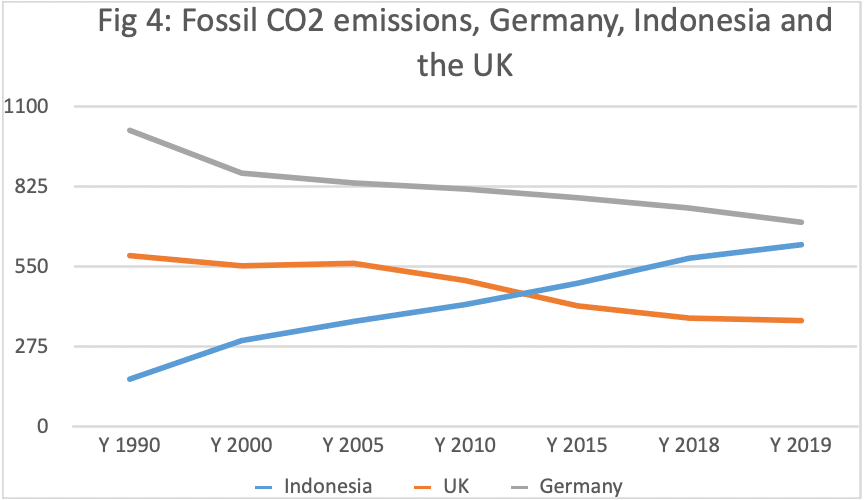
Source: European Commission, Emissions Database for Global Atmospheric Research, 2020
This trends directly opposite to the gradual decline in emissions in Europe’s leading economies, including Germany and the UK. Figure 4 compares the economies of Germany, Indonesia and the UK. One may notice that back in 1990, Indonesia played almost no role in GHG emissions, while three decades later its emissions level bypassed the UK and will soon reach Germany. In turn, both the UK and Germany are on track to GHG emissions reduction, mostly due to leading European economies shifting to low carbon electricity. Yet, Indonesia’s fossil GHG emissions are only a minor part, whereas 65% of national emissions stem from land-use change and forestry (LUCF)[21]. The Indonesian case indicates that the GHG structure in emerging Asian economies contains both the rise in fossil emissions and the destruction of the biosphere. Meanwhile, emissions have grown across all sectors, including land use, agriculture and fast-growing industries.[22] For instance, in recent years there has been mass destruction of forests across southeast Asia.[23]
-
Case studies: When energy transition transcends electricity decarbonisation
Case-by-case analysis is important to craft out both the material and socioeconomic barriers to climate action. An interesting blog article entitled ‘Five Myths about Energy Poverty’[24] reveals widespread misunderstandings about the structures and needs of emerging economies in their path to industrialisation. In fact, expert and policy communities tend to conflate access to energy, including the decarbonisation of electricity, with a need of energy transition. Authors of the article use an example of Ghana to demonstrate that the country would first require a reliable power supply and distribution systems before applying the most modern carbon-neutral electricity generators. One may guess that the same would go for charging stations for electric vehicles.
We may further expand the examples of peculiarities to smaller mountainous Asian countries, such as Nepal and Kyrgyzstan. The two can be analysed as relatively similar cases as both small nations are relying on carbon-neutral electricity generation from large hydropower generation. It means their power sectors are decarbonised to more than 90% and their populations enjoy carbon neutral electricity supplies. In turn, fossil fuels are extensively used in heating, cooking and transport, and therefore, fossil emissions easily compensate the power sector’s carbon neutrality. As a result, carbon dioxide emissions have spiked over the last two decades.

Source: European Commission, Emissions Database for Global Atmospheric Research, 2020
The situation in Nepal is certainly more challenging in terms of carbon intensity. One of the world’s poorest nations still has one of the lowest emissions rate per capita even despite the significant rise of absolute volumes in emissions in recent years. Nepal’s fast-growing urban population heavily depends on diesel and liquefied petroleum gas for cooking and heating, whereas the potential of direct electrification remains limited. The country’s power distribution remains problematic, despite hydro-based electricity production. For instance, in urban areas, power lines resemble a chaotic spaghetti of wires that pose consistent risks of power shortages and even electrocution. In this context, renovation of the power grid itself seems to be another issue which cannot be easily solved by having carbon neutral energy. For instance, residual waste – including plastic – is regularly thrown outside homes, revealing the gravity of the situation.
Compared to Nepal, Kyrgyzstan would seem in a better position in terms of fossil carbon dioxide emissions. Nevertheless, the country’s reliance on coal for heating certainly damages the situation. An introduction of electric heating would sound inconceivable since power transmission infrastructure is obsolete. Moreover, introduction of modern technologies – including solar photovoltaics and small hydropower – are limited because the energy sectors are in continuous distress.[25] Sustainable agriculture is another issue observed in the Central Asian state. Environmental groups reported a continuous destruction of forestry by an ineffective and extensive agriculture.[26]Azamat Temirkulov, the head of Green Alliance, even expressed his belief that the Kyrgyzstan’s green economy shouldn’t be solely based on best-practice transfers from the most advanced economies. Local specificities need to be taken into account first. Similarly to Nepal, the country demonstrates significant peculiarities of economic development, which certainly damage the local environment, while contributing to the unbalances in climate neutrality. What’s more, smaller economies like Nepal and Kyrgyzstan will face significant troubles in adapting to actual climate change to which smaller economies are more vulnerable.
Conclusion
This article attempted to argue against the policy conceptions which depart from generalisations and economic modelling decoupled from socioeconomic realities in place. Instead, economic laws shall not be seen independently from social practices, from the levels of socioeconomic development and from long-term economic trends of each region and country. Although the IPCC special report emphasises the need for a multidimensional approach to sustainable development, many in expert communities tend to believe in low-hanging fruits – like technology transfer and reports about applicability of western policy experiences to the rest of the world. Instead, the issue of GHG emissions abatement might require taking in to account more complex realities in place.
In turn, a sense of economic ambitions imposed on western societies might be disconnected from the IPCC Baseline scenario. Although further investments into greener and more digital economy can be defined as an opportunity,[27] a risk of additional social costs associated with the ambitious targets may dissuade western societies at large from the decarbonisation process. Moreover, doubts often accompany concerns regarding the scientific robustness of climate projections. In a recent video lecture, Isabelle Stengers – one of Europe’s most famous philosophers of science and a co-author of the Belgian Nobel Prize laureate Ilya Prigogine – outlined that doubt in science, across societies, is stronger than many would expect.[28] On a different occasion, a group of scholars proposed to cross-check the climate models that came to alarming policy conclusions because any scientific process requires a falsification process.[29] Otherwise, they argue, the legitimacy of these climate models may be strongly hindered. Social legitimacy of climate action needs to be in line with the economic realities in which western economic structures evolved.
Probably, in parallel to the already existing policy ambitions, both the EU and the US have an opportunity to reinforce their external dimension of climate action. Hopefully, the forthcoming Sixth Assessment Report will reflect socioeconomic realities of the newly emerged GHG sources and will address peculiarities and needs of emerging economies. Ultimately, a more careful case-by-case approach would help avoiding the pernicious “one size fits all” approach to the energy transition. After all, history shows that generalised economic solutions have usually failed.
[1] IPCC, Special Report, p. v.
[2] B. Bolin, ‘A History of the Science and Politics of Climate Change: The Role of the Intergovernmental Panel on Climate Change’, Cambridge University Press, 2007
[3] EU Climate Law, September 2020, URL: https://ec.europa.eu/clima/policies/eu-climate-action/law_en#:~:text=With%20the%20European%20Climate%20Law,greenhouse%20gas%20emissions%20by%202050.&text=By%20September%202023%2C%20and%20every,and%20the%202030%2D2050%20trajectory
[4] For example, an activist action on climate emergency CF https://climateemergencydeclaration.org/
[5] S. Naimoli and S. D. Ladislaw, ‘Climate Solutions Series: Decarbonizing the Electric Power Sector’ CSIS Briefs, 12 May 2020, URL: https://www.csis.org/analysis/climate-solutions-series-decarbonizing-electric-power-sector
[6] S. de Vrijs, ‘EU Strategy for Sustainable and Smart Mobility: a Manageable Transition to Climate Neutrality Rests on Competitive Technologies’, Foundry Daily News, 11.12.2020, URL: https://www.foundry-planet.com/d/eu-strategy-for-sustainable-and-smart-mobility-a-manageable-transition-to-climate-neutrality-rests-on-competitive-technologies/
[7] D. P. van Vuuren, J. Edmonds, M. Kainuma, K. Riahi, A. Thomson, K. Hibbard, G. C. Hurtt, T. Kram, V.r Krey, J.-F. Lamarque, T. Masui, M. Meinshausen, N. Nakicenovic, S. J. Smith & S. K. Rose, ‘The representative concentration pathways: an overview’, Climatic Change, Vol. 109 (5), 2011, URL https://doi.org/10.1007/s10584-011-0148-z
[8] R. Pielke, ‘It’s Time To Get Real About The Extreme Scenario Used To Generate Climate Porn’, Forbes, 26.09.2019, URL: https://www.forbes.com/sites/rogerpielke/2019/09/26/its-time-to-get-real-about-the-extreme-scenario-used-to-generate-climate-porn/?sh=23ad916d4af0
[9] IPCC, Special Report, p. 76
[10] World Climate Research programme, Official website, URL: https://www.wcrp-climate.org/wgcm-cmip
[11] G. C. Jones, P. A. Scott, J. B. Mitchell, ‘Uncertainties in the attribution of greenhouse gas warming and implications for climate prediction’, JGR Atmospheres, June 2020, URL: https://agupubs.onlinelibrary.wiley.com/doi/abs/10.1002/2015JD024337
[12] K. Andreson and J. Jewel, Climate-policy models debated, Nature forum, September 209, URL: https://media.nature.com/original/magazine-assets/d41586-019-02744-9/d41586-019-02744-9.pdf
[13] JRC, Fossil CO2 and GHG emissions of all world countries, 2018, URL: https://ec.europa.eu/jrc/en/publication/eur-scientific-and-technical-research-reports/fossil-co2-and-ghg-emissions-all-world-countries-0
[14] JRC, Fossil CO2 and GHG emissions of all world countries, 2018, URL: https://ec.europa.eu/jrc/en/publication/eur-scientific-and-technical-research-reports/fossil-co2-and-ghg-emissions-all-world-countries-0
[15] BP Statistical Report, 2020, Carbon dioxide emissions, URL: https://www.bp.com/content/dam/bp/business-sites/en/global/corporate/pdfs/energy-economics/statistical-review/bp-stats-review-2020-co2-emissions.pdf
[16] A. Yadav, ‘An Empirical Study on Environmental Issues in India’, Global Journal of Management and Business Studies, Research India Publications, pp. 949-954
[17] TERI, New energy (biofuels, solar, and wind) and implications for land as a resource, 2014, URL: https://www.teriin.org/project/new-energy-biofuels-solar-and-wind-and-implications-land-resource
[18] X.Li, K. J. Chalvatzis, D. Pappas, “China’s electricity emission intensity in 2020 – an analysis at provincial level”, Energy Procedia, Vol. 142, 2017, pp. 2779-2785
[19] REEI, Energy Review, Energy Transition in China: the way toward a low emission transport sector, p. 32, URL: http://en.reei.org.cn/upload/file/20191129/1575010666408996.pdf
[20] Council of Foreign Relations, 18.01.2016, URL: https://www.cfr.org/backgrounder/chinas-environmental-crisis
[21] USAID, Greenhouse Gas Emissions Factsheet: Indonesia, 2017, URL: https://www.climatelinks.org/resources/greenhouse-gas-emissions-factsheet-indonesia#:~:text=Much%20of%20Indonesia’s%202013%20GHG,and%20industrial%20processes%20(1.4%25).
[22] A. Wijaya, H. Chrysolite, M.Ge, C. K. Wibowo, A. Pradana, A. Firselly Utami and K. Austin, ‘How Can Indonesia Achieve Its Climate Change Mitigation Goal? An Analysis of Potential Emissions Reductions from Energy and Land-Use Policies’, report for the World Resource Institute, 2017, URL: https://www.wri.org/publication/how-can-indonesia-achieve-its-climate-goal
[23] BBC News, 16.09.2020 URL: https://www.bbc.com/news/world-asia-34265922
[24] T. Schuller, T., Moss, Five Myths about Energy Poverty, Scientific American, Opinions 13 October 2019, URL: https://blogs.scientificamerican.com/observations/five-myths-about-energy-poverty/?amp&fbclid=IwAR1n87OBy-7wJqlkdGXVsEM8lw-r1otP_8pfUJEFdZ6J5eKXWPj-5RhHYXs (accessed 31 January 2020)
[25] World Bank, Kyrgyz Republic Energy Sector, URL: https://www.worldbank.org/en/country/kyrgyzrepublic/brief/energy-sector
[26] Discussions raised during a worksop organised by Konrad Adenauer Stiftung, 12.12.2019, Bishkek, Kyrgyzstan
[27] A. Belyi, ‘Investing in Digital to go Green’, Energy Central, September 2020, URL: https://energycentral.com/c/iu/investing-digital-means-going-green-innovative-cases-renewables-and-e-mobility
[28] I. Stengers, videolecture, faire commun face au désastre, 15.05.2020, URL : https://t.co/bVh7KYeLwV?amp=1
[29] Asayama, S., Bellamy, R., Geden, O., Pearce, W. and Hulme, M., “Why setting a climate deadline is dangerous”, Nature Climate Change, 9, 2019, pp. 570-74;
Image par Darwin Laganzon de Pixabay